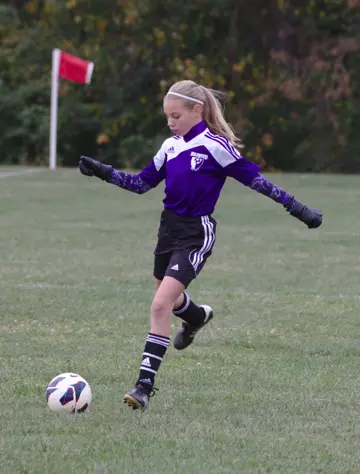Spondylolisthesis – Madison Moeller
 Madison Moeller loves soccer. The 12-year-old dreams of being on the U.S. Women’s National Soccer Team. When she started to have pain in her back and leg, her parents chalked it up to being an active athlete. Over time, the pain worsened. Her gait changed. Maddy, as she is known to family and friends, told her parents her left leg would sometimes go numb. “The pain was so bad, I could barely walk across a parking lot without having to sit down,” said Maddy.
Madison Moeller loves soccer. The 12-year-old dreams of being on the U.S. Women’s National Soccer Team. When she started to have pain in her back and leg, her parents chalked it up to being an active athlete. Over time, the pain worsened. Her gait changed. Maddy, as she is known to family and friends, told her parents her left leg would sometimes go numb. “The pain was so bad, I could barely walk across a parking lot without having to sit down,” said Maddy.
Her mom, Amy, took her to a doctor who ordered x-rays. They will never forget what they saw. “We were all in shock,” said Maddy’s father, Mike. The x-rays showed deformities in Maddy’s lower spine. One vertebrae had slipped so far forward, it was almost falling off the other. The St. Albans, Missouri, family immediately set out to find the top spine surgeon in St. Louis.
The search brought them to Munish Gupta, MD, a Washington University School of Medicine spine specialist. Dr. Gupta focuses on complex spinal reconstructive surgery in children and adults, including Maddy’s condition: high grade spondylolisthesis.
Spondylolisthesis develops over time. The symptoms present in pediatric patients around the age of 10. Dr. Gupta explained to Maddy and her family that in some cases, decisions about surgery can be gray. In Maddy’s case, it was black and white. She needed the operation.
When they met, Maddy told Dr. Gupta of her dream to one day play professional soccer. “Dr. Gupta showed her a picture of his son with Lionel Messi,” Mike said. “Maddy considers Messi the greatest soccer player ever.” For Maddy, it was more than a shared appreciation for soccer. “Dr. Gupta made me feel comfortable from the beginning,” she said.
In May 2016, Maddy’s parents handed her over to the doctors, nurses and staff at St. Louis Children’s Hospital for about eight hours.
“As we were preparing for surgery, someone said to Maddy that she had been dealt a rotten hand,” said Mike. “I remember our response: ‘It is not the hand you are dealt, but it is what you do with it that counts.’ Maddy’s condition before surgery had deteriorated so much she could not walk or stand for very long. She was in intense pain and had little quality of life. Yet, she also knew she has a powerful testimony to help others overcome challenges in their lives.”
Dr. Gupta used screws and rods, bone grafts and fusion to repair Maddy’s spine. Normally, patients recovering from this type of surgery wait a year to fully engage in activities. “Patient outcome depends a lot on the patient, their condition and the surgery,” said Dr. Gupta. He gave Maddy the go-ahead to return to soccer just six months later. “Maddy is very motivated, young and healthy. Her condition was severe and painful but fortunately, everything went well and the outcome is good.”
A few tears were shed when Maddy returned to the soccer field just seven months later. But not by Maddy. She focused on doing the most with what she has: a newly repaired spine.